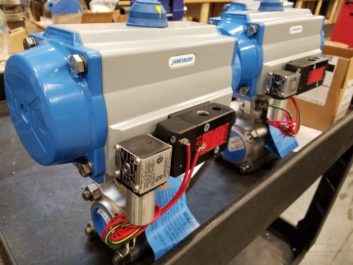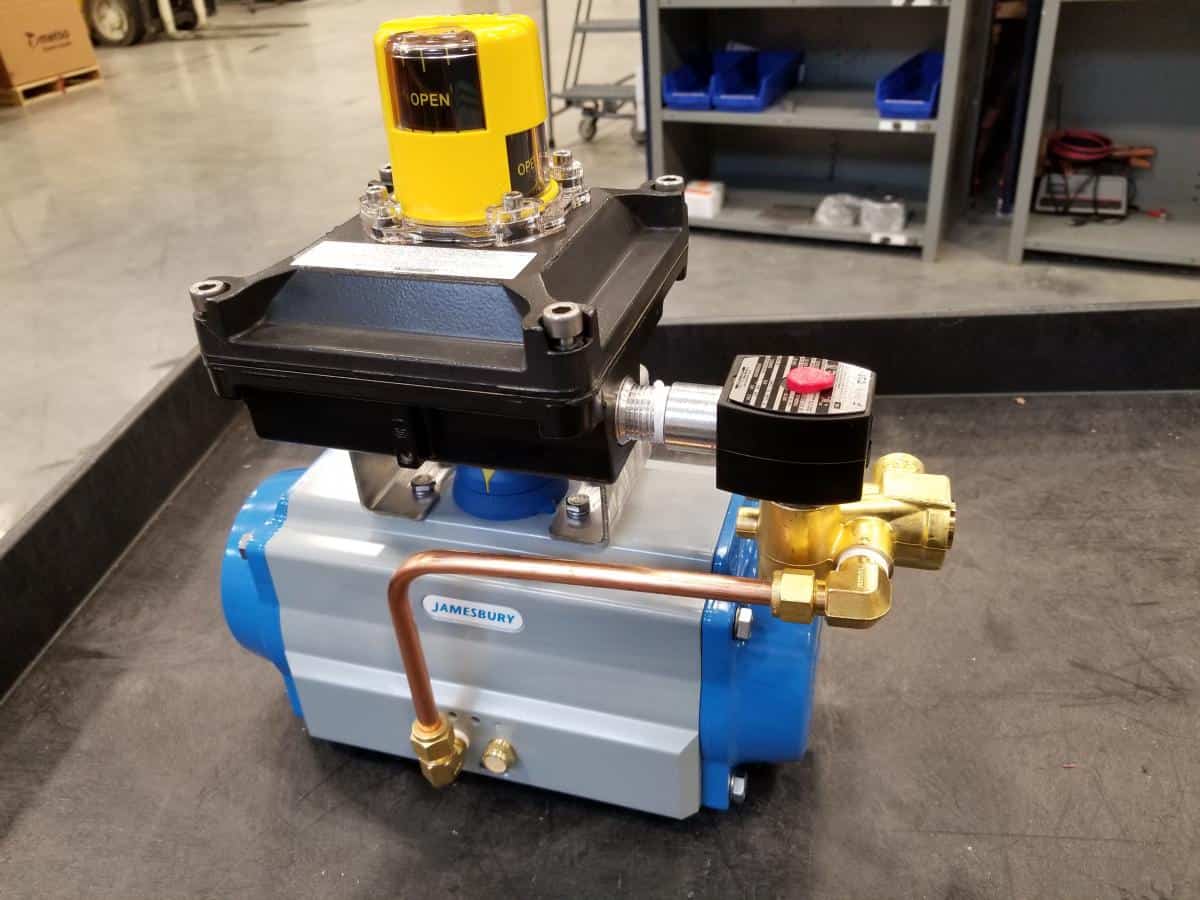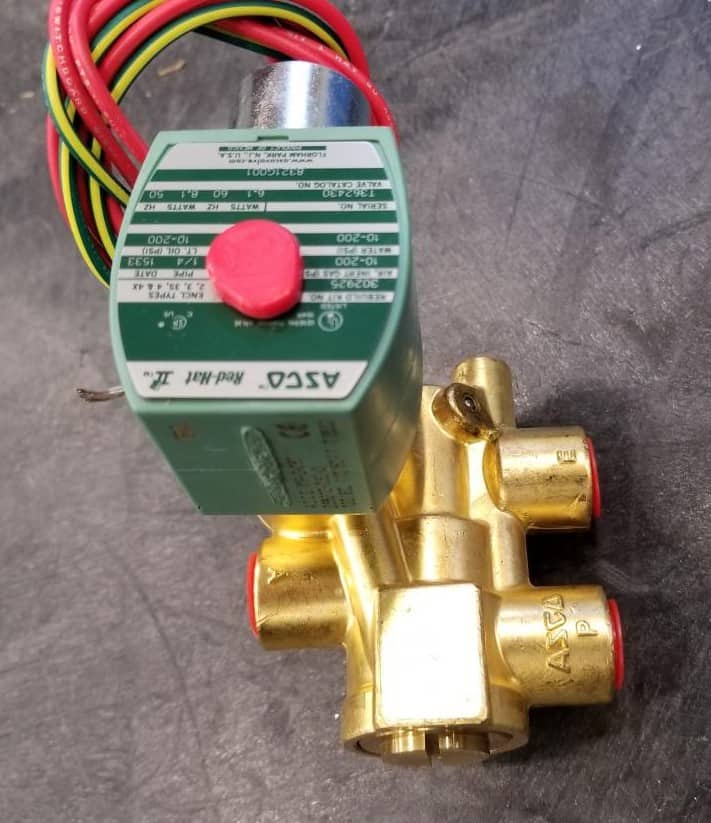Which solenoid valve do you need to control your pneumatic shutoff valve?
Direct mounted, remote mounted, three-way, four-way, five-way, AC, DC, normally open, normally closed? So many choices and what does all this mean? I just want to open and close my valve, so why does all of this matter? And what is an electro-pneumatic solenoid valve anyway?

What Is an Electro-pneumatic Solenoid Valve?

Remote Mount Solenoid Valve
First, let’s start with a very basic definition of an electro-pneumatic solenoid valve. An electro-pneumatic solenoid valve takes an electrical signal (AC or DC Voltage) and opens or closes the air supply going to your pneumatic actuator. Very basic solenoids consist of an electromagnetic coil, a plunger or piston, a piston return spring, and a valve body. When you apply electrical power to the coil, it attracts the piston and causes it to move inside the valve body. This, in turn, opens or closes ports inside the valve body allowing your air supply to operate the pneumatic actuator. When you remove the electrical supply, the piston spring returns the piston to its original position and shuts off the air supply to the pneumatic actuator.
To choose the correct solenoid for your actuator, you need to know what is really happening inside the solenoid as well as what is happening inside your actuator.
How to Select the Correct Solenoid
Now let’s look at basic types of actuators and then decide what type of solenoid we need to operate them. Most pneumatic valve actuators fall into one of two categories: double acting (fail in place) or spring return (fail open or fail closed). Many pneumatic actuators consist of either one or two pistons inside a cylinder that connects to a rod or pinion which operates your valve.
There are also diaphragm actuators that utilize a rubber diaphragm with a spring attached to a rod, which operates the valve. Spring return actuators have springs on the ends of the pistons that return the pistons to a specific position when the air is removed from the actuator. When you add air to one side of the piston(s) or diaphragm, you must vent air from the opposite side in order for the piston or diaphragm to move and operate your valve. If you do not vent the actuator, it will not completely stroke the valve. You must also vent the pressure side of the piston(s) or diaphragm as the actuator is returning to its normal position.
Modern rack & pinion actuators have universal “NAMUR” supply port configurations that allow the use of special direct mount solenoids to eliminate the need for tubing or fittings. Remote mount solenoids can be mounted on or near the actuators and require the air to be piped to the actuator. Remote mount solenoids are useful if the actuator is in a harsh or hot environment that might affect the operation of the solenoid’s electronics.

The terms “three-way” (pictured left), “four-way,” and “five-way” refer to the port configurations inside the solenoid valve body. These ports direct your air supply as well as the actuator’s exhaust when the electric coil is energized or de-energized. For example, a three-way solenoid has one pressure inlet port, one pressure outlet port that goes to operate the pneumatic actuator (coil energized), and it has an exhaust port to vent pressure from the actuator’s pressure side when the coil is de-energized. Three-way solenoids are used primarily on spring return actuators. Three-way solenoids only pressurize and vent one side of the actuator’s pistons. The spring return actuator usually has a built-in vent for the non-pressure side of the piston(s) or diaphragm.
Four-way solenoids have one pressure inlet port, two pressure outlet ports and share an exhaust port for both sides of the actuator piston. A five-way solenoid is similar to the four-way except they have one inlet pressure port, two outlet pressure ports, and two independent exhaust ports. Four-way and five-way solenoids are primarily used on double acting actuators. They allow you to pressurize and vent each side of the actuator’s pistons. Four-way and five-way solenoids may have either one or two electromagnetic coils. Single coil versions will cause your actuator to be fail closed or fail open on loss of power. Dual coil solenoids will cause your actuator to remain in place if there is a loss of power. If you do not have a four-way or five-way solenoid readily available, you can use two three-way solenoids to control each side of a double acting actuator independently. This configuration will duplicate the operation of a dual coil solenoid.
Generally, you will need normally closed solenoids for automating your actuators. normally closed or normally open refers to the position of the solenoid when the coil is de-energized. A normally closed solenoid will block the air supply from the actuator when the coil is de-energized. Normally open solenoids allow an open path for the air supply to reach the actuator when the coil is de-energized.
Questions to answer when selecting a solenoid:
- What type actuator do I have (fail open or fail closed)
- What do I want my actuator to do if I lose power to my coil?
- Do I want a direct mount or remote solenoid?
- Do I need a normally closed solenoid (most common application)?
- Do I need three-way, four-way, or five-way?
- What is my signal voltage?
- What port size do I need in my solenoid body?
- What materials of construction do I need the solenoid made from?
- Does the solenoid need to be explosion proof or just watertight?
- What is the ambient temperature the solenoid will see?
- What is the supply pressure of my air?
If you have the answers to these questions in hand, your solenoid supplier can offer the correct solenoid for your application. These are the basic items you need to consider when asking for a solenoid. Consult your solenoid supplier if you need your actuator to open or close in a specific amount of time. Most suppliers have access to sizing tools to calculate the speed in which the solenoid will stroke your actuator, but this will require answers to many more questions.
If you need help in selecting the correct solenoid valve to control your pneumatic shutoff valve, contact Cross today to speak with one of our valve experts.
